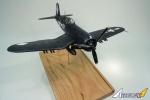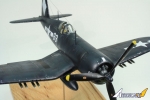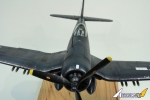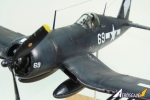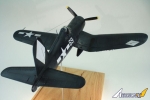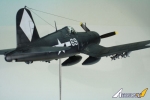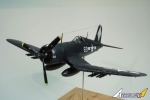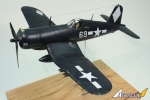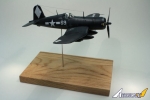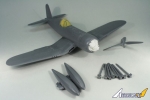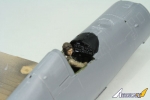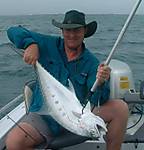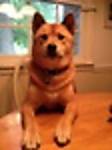1⁄48Junior Modeller's Showcase: Corsair
7
Comments
history
The Chance Vought F4U Corsair was an American fighter aircraft that saw service primarily in World War II and the Korean War. Demand for the aircraft soon overwhelmed Vought's manufacturing capability, resulting in production by Goodyear and Brewster: Goodyear-built Corsairs were designated FG and Brewster-built aircraft F3A. From the first prototype delivery to the U.S. Navy in 1940, to final delivery in 1953 to the French, 12,571 F4U Corsairs were manufactured by Vought, in 16 separate models, in the longest production run of any piston-engined fighter in U.S. history (1942–53).The Corsair was designed as a carrier-based aircraft. However its difficult carrier landing performance rendered the Corsair unsuitable for Navy use until the carrier landing issues were overcome when used by the British Fleet Air Arm. The Corsair thus came to and retained prominence in its area of greatest deployment: land based use by the U.S. Marines. The role of the dominant U.S. carrier based fighter in the second part of the war was thus filled by the Grumman F6F Hellcat, powered by the same Double Wasp engine first flown on the Corsair's first prototype in 1940. The Corsair served to a lesser degree in the U.S. Navy. As well as the U.S. and British use the Corsair was also used by the Royal New Zealand Air Force, the French Navy Aéronavale and other, smaller, air forces until the 1960s. Some Japanese pilots regarded it as the most formidable American fighter of World War II] and the U.S. Navy counted an 11:1 kill ratio with the F4U Corsair.
After the carrier landing issues had been tackled it quickly became the most capable carrier-based fighter-bomber of World War II. The Corsair served almost exclusively as a fighter-bomber throughout the Korean War and during the French colonial wars in Indochina and Algeria.
History adapted from Wikipedia.
the model
This is the Tamiya kit Vought F4U-1D with Tug. I used a photo from the Squadron book F4U Corsair in Action as my inspiration. The photo in the book and the instructions list the plane as No 69 from VMF 214 on-board the USS FRANKLIN in March of 1945.I changed the pilot to be looking out the right side of the aircraft instead of looking out the back with the cockpit open like the instructions list. This was my first attempt in changing a figure, which turned out well.
I really like the kit; it was easy to assemble with the only difficulty was getting the flaps in the up position since they have tabs to lock them in the down position.
I primed with Vallejo gray primer, preshaded with flat black then went on to paint aluminuim in certain spots which then received salt to represent chipping. Afterwards I used Vallejo Signal Blue for the base coat, then darkened the panel lines and then lightened the panel centers. I used Pledge floor polish to seal the aircraft followed by decals more Pledge and chipping and an oil paint pin wash. Then a dull clear coat to top it off.
Comments
Ryan, outstanding instrument panel, really nice pilot, overall a super job! I agree the fading and chipping look great!
JAN 30, 2015 - 10:18 AM
Great looking Corsair. Your weathering accents are very good as well.
Best wishes,
Ian
JAN 30, 2015 - 10:20 AM
Ryan, an excellent build and presentation of one of my favorite prop aircraft.
JAN 31, 2015 - 09:07 PM
Nice job Ryan! I think you really nailed it with this bird!
—mike
FEB 06, 2015 - 07:01 AM
Copyright ©2021 by Ryan Potts. Images also by copyright holder unless otherwise noted. The views and opinions expressed herein are solely the views and opinions of the authors and/or contributors to this Web site and do not necessarily represent the views and/or opinions of AeroScale, KitMaker Network, or Silver Star Enterrpises. Images also by copyright holder unless otherwise noted. Opinions expressed are those of the author(s) and not necessarily those of AeroScale. All rights reserved. Originally published on: 2015-01-30 20:15:51. Unique Reads: 3426





